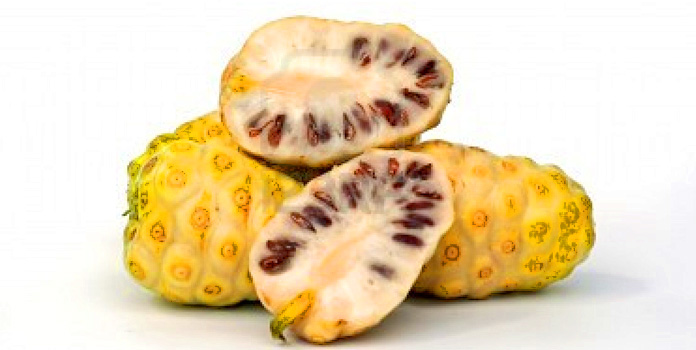Herbs A-B
Herbs C-D
Herbs E-M
Botanical Name : Morinda citrifolia
Other Names : Great morinda, Noni, Mengkudu, Dibri-Apra
Morinda citrifolia, commonly known as Great morinda, Indian mulberry, Beach mulberry, Tahitian Noni, or since recently: Noni (from Hawaiian), Nono (in Tahitian), Mengkudu (from Malay), Nonu (in Tongan), and Ach (in Hindi), is a shrub or small tree in the family Rubiaceae. Morinda citrifolia is native to Southeast Asia but has been extensively spread by man throughout India and into the Pacific islands as far as the islands of French Polynesia, of which Tahiti is the most prominent. It can also be found in parts of the West Indies.
Noni grows in shady forests as well as on open rocky or sandy shores. It reaches maturity in about 18 months and then yields between 4-8 kg of fruit every month throughout the year. It is tolerant of saline soils, drought conditions, and secondary soils. It is therefore found in a wide variety of habitats: volcanic terrains, lava-strewn coasts, and clearings or limestone outcrops. It can grow up to 9 m tall, and has large, simple, dark green, shiny and deeply veined leaves. The richest of the soils in which noni grows are found in French Polynesia.

The plant flowers and fruits all year round. The flowers are small and white. The fruit is a multiple fruit that has a pungent odor when ripening, and is hence also known as cheese fruit or even vomit fruit. It is oval and reaches 4-7 cm in size. At first green, the fruit turns yellow then almost white as it ripens. It contains many seeds. It is sometimes called starvation fruit. Despite its strong smell and bitter taste, the fruit is nevertheless eaten as a famine food[1] and, in some Pacific islands, even a staple food, either raw or cooked.[2] Southeast Asians and Australian Aborigines consume the fruit raw with salt or cook it with curry. The seeds are edible when roasted.
The noni is especially attractive to weaver ants, which make nests out of the leaves of the tree. These ants protect the plant from some plant-parasitic insects. The smell of the fruit also attracts fruit bats, which aid in dispersing the seeds.
Uses as food:
The fruits are edible, but don't have a nice taste or smell. In fact, some people consider the ripe fruits to smell like vomit!
Nevertheless, the fruits were eaten as a famine food, and in some Pacific islands, are even a staple food of choice (Raratonga, Samoa, Fiji), where they were eaten raw or cooked. Elsewhere, the fruit is eaten raw with salt (Indochina, Australian Aborigines); or cooked as a curry. The fruits may also be fed to pig livestock. The young leaves can also be eaten as a vegetable and contain protein (4-6%). Seeds may be roasted and eaten.
Other uses: The bark of the Great Morinda produces a reddish purple and brown dye used in making batik and the tree was widely grown for this purpose in Java. In Hawaii, a yellowish dye was also extracted from the roots and also used to dye cloth. The tree was also purposely planted to provide support for pepper vines and shade tree for coffee bushes. Also as a wind-break in Surinam.
Traditional medicinal uses:
Various parts are used to contain fever and as a tonic (Chinese, Japan, Hawaii); leaves, flowers, fruit, bark to treat eye problems, skin wounds and abscesses, gum and throat problems, respiratory ailments, constipation, fever (Pacific Islands, Hawaii); to treat stomach pains and after delivery (Marshall Islands). Heated leaves applied to the chest relieve coughs, nausea, colic (Malaysia); juice of the leaves is taken for arthritis (Philippines). The fruit is taken for lumbago, asthma and dysentery (Indochina); pounded unripe fruit is mixed with salt and applied to cuts and broken bones; ripe fruit is used to draw out pus from an infected boil (Hawaii); juices of over-ripe fruits are taken to regulate menstrual flow, ease urinary problems (Malay); fruits used to make a shampoo (Malay, Hawaii) and to treat head lice (Hawaii). Other exotic diseases treated with the plant include diabetes (widespread) and venereal diseases.
Statements on this website is collected from online and offline references, they are an effective way of learning and sharing. With this knowledge, we can take control of our own health. These statements have not been evaluated by the FDA. Products and techniques mentioned here are not intended to diagnose, treat, cure or prevent any disease. However, when you give the body what it needs then the body can heal itself as God intended it to. We are bulk suppliers/Exporters of herbs, and raw materials this website is intend to provide option for various herbs buyers/importers/our customers, buy small Qty swiftly and pay for the product and shipping.